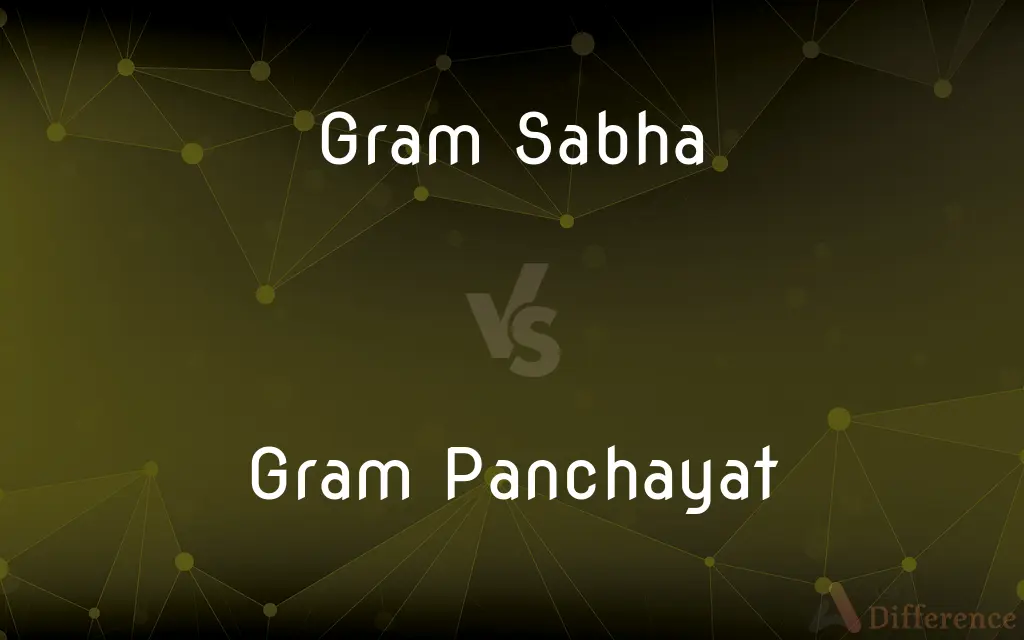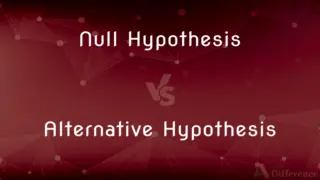Gram Sabha vs. Gram Panchayat — What's the Difference?
Edited by Tayyaba Rehman — By Fiza Rafique — Published on December 19, 2023
Gram Sabha is a village assembly, while Gram Panchayat is a local government council.

Difference Between Gram Sabha and Gram Panchayat
Table of Contents
ADVERTISEMENT
Key Differences
Gram Sabha is a body comprising all adults who live in the area covered by a village Panchayat. It is the fundamental unit of local self-government, acting as a village assembly where all eligible voters can participate. Gram Panchayat, on the other hand, is the executive committee of the Gram Sabha and acts as the decision-making body, which is elected by the members of the Gram Sabha.
While Gram Sabha serves as the cornerstone for exercising powers and responsibilities at the village level, it primarily functions in an advisory capacity and provides a platform for discussion and decision-making about village affairs. Gram Panchayat is responsible for implementing the decisions of the Gram Sabha and administering the daily affairs and community projects of the village.
In terms of power dynamics, the Gram Sabha holds the Panchayat accountable by reviewing its decisions and actions. It's a direct democracy platform. Conversely, the Gram Panchayat is a form of representative democracy, where elected representatives manage the village's administration and development activities.
The scope of functions differs as well; the Gram Sabha has the power to identify beneficiaries for various programs and schemes, and to play a role in the planning process. The Gram Panchayat, in contrast, is tasked with implementing these schemes and managing resources such as water, roads, and welfare programs.
Gram Sabha meetings are usually held two to four times a year and are vital for ensuring transparency and accountability in the functioning of the Gram Panchayat. The Gram Panchayat, however, meets more frequently to carry out its administrative duties and to ensure the execution of plans formulated during the Gram Sabha meetings.
ADVERTISEMENT
Comparison Chart
Nature
Village Assembly
Local Government Council
Membership
All adult residents of the village
Elected members
Frequency of Meetings
2-4 times a year
More frequent
Role
Advisory, Decision-making
Execution, Administration
Decision Power
Identifies beneficiaries, advises plans
Implements decisions, manages resources
Compare with Definitions
Gram Sabha
Gram Sabha is instrumental in grassroots decision-making.
The Gram Sabha played a key role in selecting the beneficiaries for the housing scheme.
Gram Panchayat
Gram Panchayat is the local self-government at the village level.
The Gram Panchayat organized a health camp for the villagers.
Gram Sabha
Gram Sabha holds the Panchayat accountable.
In the Gram Sabha, villagers questioned the Panchayat's spending on the new road project.
Gram Panchayat
Gram Panchayat manages local resources and schemes.
The Gram Panchayat distributed seeds and fertilizers to the farmers.
Gram Sabha
Gram Sabha consists of all adult residents of a village.
Everyone in the village is encouraged to participate in the Gram Sabha to voice their opinions.
Gram Panchayat
Gram Panchayat comprises elected representatives.
She was elected as the head of the Gram Panchayat last year.
Gram Sabha
Gram Sabha is a democratic village assembly.
The villagers gathered for the quarterly Gram Sabha meeting to discuss local issues.
Gram Panchayat
Gram Panchayat is responsible for executing decisions.
The Gram Panchayat ensured the construction of new roads as per the plan.
Gram Sabha
Gram Sabha serves as a platform for direct democracy.
During the Gram Sabha, villagers voted on the proposed development plan.
Gram Panchayat
Gram Panchayat administers village development.
The Gram Panchayat successfully implemented the clean water initiative.
Common Curiosities
What is the role of Gram Sabha in democracy?
Gram Sabha serves as a platform for direct democracy at the village level.
What is a Gram Sabha?
Gram Sabha is a village assembly comprising all adult residents of a village.
What is a Gram Panchayat?
Gram Panchayat is the elected governing body at the village level.
How is a Gram Panchayat formed?
A Gram Panchayat is formed through elections, where villagers vote for their representatives.
What are the main functions of a Gram Sabha?
A Gram Sabha advises on village development plans, identifies beneficiaries for schemes, and holds the Panchayat accountable.
How often does a Gram Sabha meet?
A Gram Sabha generally meets two to four times a year.
Who can participate in a Gram Sabha?
Any adult resident of the village can participate in the Gram Sabha.
Is attendance at Gram Sabha meetings mandatory?
While it's not legally mandatory, it's highly encouraged for all eligible villagers to attend Gram Sabha meetings.
What are the responsibilities of a Gram Panchayat?
A Gram Panchayat is responsible for implementing development plans, managing local resources, and administering village affairs.
Can a member of the Gram Sabha be part of the Gram Panchayat?
Yes, members of the Gram Sabha can contest elections and be elected to the Gram Panchayat.
Can decisions of the Gram Panchayat be overturned by the Gram Sabha?
Yes, decisions of the Gram Panchayat can be questioned and advised for reconsideration by the Gram Sabha.
How often does a Gram Panchayat meet?
A Gram Panchayat meets more frequently, often monthly, to manage administrative duties.
Are the meetings of the Gram Sabha open to the public?
Yes, Gram Sabha meetings are open for all villagers to attend and participate.
What powers does the Gram Sabha have over the Gram Panchayat?
The Gram Sabha has the power to review and question the decisions and actions of the Gram Panchayat.
Who leads the meetings of the Gram Panchayat?
The head of the Gram Panchayat, often referred to as the Sarpanch, leads the meetings.
Share Your Discovery

Previous Comparison
Offer Letter vs. Employment Letter
Next Comparison
Null Hypothesis vs. Alternative HypothesisAuthor Spotlight
Written by
Fiza RafiqueFiza Rafique is a skilled content writer at AskDifference.com, where she meticulously refines and enhances written pieces. Drawing from her vast editorial expertise, Fiza ensures clarity, accuracy, and precision in every article. Passionate about language, she continually seeks to elevate the quality of content for readers worldwide.
Edited by
Tayyaba RehmanTayyaba Rehman is a distinguished writer, currently serving as a primary contributor to askdifference.com. As a researcher in semantics and etymology, Tayyaba's passion for the complexity of languages and their distinctions has found a perfect home on the platform. Tayyaba delves into the intricacies of language, distinguishing between commonly confused words and phrases, thereby providing clarity for readers worldwide.
















































